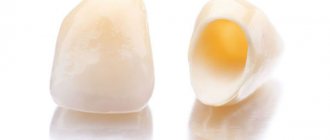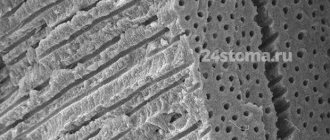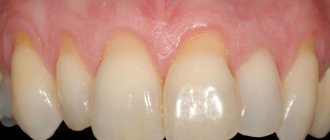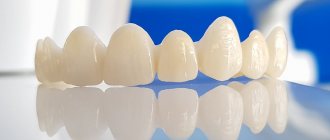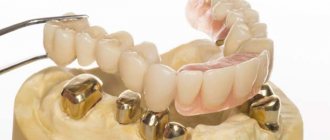Author of the article:
Soldatova Lyudmila Nikolaevna
Candidate of Medical Sciences, Professor of the Department of Clinical Dentistry of the St. Petersburg Medical and Social Institute, Chief Physician of the Alfa-Dent Dental Clinic, St. Petersburg
Not only the health of teeth and gums, but also the functioning of the digestive, immune and other systems and organs depends on the state of the oral microflora. Let's figure out what this part of the body is, what affects the conditions of the oral cavity and how to quickly restore the normal functioning of the microflora.
What is the microflora of the oral cavity?
Surprisingly, approximately 160 species of microorganisms live in the mouth of a healthy person. You've probably heard that “the mouth is the dirtiest place in the body.” This statement is partly true: the oral cavity is one of the most populated parts of the human body.
Microorganisms enter the oral cavity with food and water, as well as from the air. It is in the mouth that the most favorable conditions for the development of bacteria are observed. This part of the body always has uniform humidity and temperature (approximately 37 °C). The abundance of nutrients, sufficient oxygen content, the presence of folds in the oral cavity, interdental spaces and gum pockets, and slightly alkaline pH provoke the proliferation of various bacteria.
Microorganisms are unevenly distributed in the oral cavity. Their maximum number is observed on the surface of the teeth and on the back of the tongue. One gram of dental plaque contains approximately 300 billion microbes, and saliva contains approximately 900 million per 1 milliliter.
- 30-60% of the microflora are facultative and obligate anaerobic streptococci;
- part is occupied by Veillonella, coccobacteria, which ferment acetic, pyruvic and lactic acids to water and carbon dioxide. It is Veillonella that neutralizes acidic foods, so many dentists consider them as destroyers of cariogenic bacteria;
- Bacteria of the genera Propionibacterium, Corynebacterium and Eubacterium are also necessarily present in the mouth, which actively produce molecular oxygen, synthesize vitamin K and promote the development of obligate anaerobes. Some types of such bacteria provoke purulent inflammation.
- Lactobacilli are strict anaerobes. There are more than 10 types of similar bacteria in the mouth that form a biofilm in the cavity. The vital activity of these microorganisms creates a favorable environment for the development of normal microflora. Lactobacilli ferment carbohydrates to form lactic acid, lower the pH, and most importantly, prevent the development of pathogenic, putrefactive and gas-forming microflora.
- Rod-shaped lactobacilli in a certain amount are, like streptococci, producers of lactic acid.
- Bifidobacteria are necessary to ferment various carbohydrates, as well as produce B vitamins and antimicrobial substances that inhibit the growth of pathogenic microorganisms. Moreover, bifidobacteria are a bunch of epithelial cell receptors: they form a film that prevents the colonization of pathogenic bacteria.
It would take a very long time to list all the types of bacteria that populate the microflora of the oral cavity. It is important to understand that each person is unique, and to assess the “normality” of the microflora, you need to know the characteristics of a particular organism.
For example, in one case, a large number of lactobacilli in the oral cavity will preserve teeth, and in another, the formation of a large amount of lactic acid during their vital activity will retard the growth of other important microorganisms. The number of staphylococci, dysentery and typhoid bacilli decreases, carious processes become more active, and the microflora of the oral cavity will have to be restored.
Disturbance of oral microflora: causes
Oral dysbiosis can be caused by a variety of diseases and problems. Violation of opportunistic microflora of the oral cavity most often causes problems such as:
- Diseases of the gastrointestinal tract. Malfunctions of the digestive organs lead to a slowdown in metabolic processes in the body. The absorption of vitamins and nutrients deteriorates, the balance of the intestinal bacterial environment is disrupted, which provokes problems in other organs and systems.
- Decreased immunity. If the body's resistance deteriorates, the oral cavity automatically becomes more vulnerable to pathogenic microflora.
- Chronic diseases. Often, small caries or stomatitis, if left untreated, can spread from the source of inflammation to the entire oral cavity.
- Bad habits, such as systematic drinking of alcohol and smoking, inevitably affect the quality of the salivary glands. Prolonged drying out or too much moisture in the oral cavity has a detrimental effect on the composition of the microflora.
- Poor nutrition and lack of vitamins worsens the quality of saliva and makes the microflora of the oral cavity more vulnerable.
- Taking antibiotics and certain medications, such as hormones;
- Wearing dentures.
How to avoid re-infection
Doctors' recommendations are simple and concise. The following rules will help you avoid relapse:
- Maintaining personal hygiene rules
- Complete the course of treatment with prescribed medications
- Do not self-medicate or self-diagnose
- Do not try untested methods on yourself
- Be periodically tested for enterobiasis
- If you suspect a relapse, consult a doctor
If the test result is positive, then do not be upset. Getting rid of parasites is not difficult. It is enough to carry out an appropriate course of treatment.
Stages of dysbiosis
Depending on the degree of development of the disease, dentists distinguish four stages of dysbiosis:
- Latent. The first, latent stage is characterized by subtle changes in the number of microorganisms of one strain. The patient feels well and does not experience any symptoms of inflammation.
- Subcompensated. The number of lactobacilli decreases, the disease has a blurred picture. The patient may feel discomfort in the oral cavity, but does not always understand that this is dysbacteriosis.
- Pathogenic. Lactobacilli are observed in minimal quantities in the oral cavity. The oral cavity begins to be populated by a facultative pathogenic environment.
- Decompensated. In addition to severe inflammation in the mouth, uncontrolled growth of yeast-like fungi occurs. The functioning of the salivary glands is disrupted, and an unpleasant taste and burning sensation occurs in the mouth.
Advanced forms of dysbiosis are characterized by symptoms such as:
- inflammation of the gums and mucous membranes;
- plaque on the teeth and surface of the tongue;
- bleeding gums;
- ulcers and blisters on mucous membranes;
- increased body temperature;
- swelling and soreness of the tongue;
- dry skin, sticking in the corners of the mouth.
Candida test
Candidiasis is a disease caused by yeast-like fungi Candida, which can affect the skin, mucous membranes, and internal organs.
Candida fungi are ubiquitous - in soil, water, on vegetables and fruits, everyday items, household items, etc., etc. They are also present in the human body, in small quantities being part of the normal microflora.
The Candida fungus is a round or oval single-celled plant organism. Its wall is constructed in such a way that it reliably protects the microorganism from the effects of adverse environmental conditions and medications. The optimal temperature for Candida growth is from +20°C to 27°C. However, even at a body temperature of 37°C, mushrooms feel quite comfortable.
The genus of yeast-like fungi Candida has about 170 representatives. The most common of all fungi of this species is the species Candida albicans. In the human body, fungi can settle on the skin or mucous membranes - in the mouth, vagina, gastrointestinal tract, etc., without betraying their presence in any way. Candida especially “loves” tissues containing a lot of glucose or its compounds (the microorganism absorbs sugar very well), so candidiasis is often found in patients with diabetes.
The impetus for the development of a number of diseases caused by candida (for example, bacterial vaginosis or “thrush”, pneumonia in newborns, inflammation of the urethra, various purulent diseases, stomatitis, systemic candidiasis) can be factors that cause a malfunction of the immune system or depression its functions, for example:
- severe infectious diseases;
- HIV infection and other immunodeficiency conditions;
- oncological diseases;
- diabetes;
- use of new generation antibiotics;
- use of corticosteroid drugs;
- old age or childhood;
- pregnancy.
The development of a fungal infection occurs, as a rule, within the body itself (autoinfection) on the basis of fungi included in the normal microflora. However, infection can also occur from outside. With candidiasis, the properties of the fungus remain unchanged - only the body’s reaction to it changes (the level of local protection decreases). Candidiasis can occur in one of two forms:
- superficial, in which the skin and mucous membranes are affected;
- deep, with possible damage to several body systems, internal organs, and penetration of the fungus into the blood.
The parasitic fungus attaches to the epithelial cells of the mucosa and penetrates into the thickness of the tissue. The degree of deepening can vary from damage to surface cells to the entire thickness of the mucosa. The body resists the fungus, which can lead to dynamic equilibrium. The essence of this phenomenon lies on the part of the fungus in the desire to go deeper and the impossibility of doing this, and on the part of the body - to force out the uninvited guest, which is also not crowned with success. This balance can be maintained for years. As a result of displacement, either recovery or relapse of the disease occurs. Individuals with immunodeficiency may develop both forms of infection. In an organism with a normally functioning immune system, only superficial candidiasis is observed.
Depending on the lesion, the following types of candidiasis are distinguished:
- candidiasis of the mucous membranes of the oral cavity;
- urogenital candidiasis (fungal infection of the mucous membranes and skin of the genitourinary organs);
- candidiasis of the skin and its appendages (sweat and sebaceous glands, hair, nails);
- visceral candidiasis (affecting internal organs and systems, causing their inflammation);
- Chronic generalized candidiasis (total damage to the body that occurs in the absence of adequate therapy, with the subsequent transition of the disease to a chronic form, and the possible development of candidal sepsis in the absence of further treatment).
Candidiasis of the skin and its appendages is characterized by the formation of lesions in large folds, inguinal cavities, under the mammary glands, and smaller interdigital folds. In people suffering from severe pathologies, the fungus can affect the palms, feet, smooth skin of the limbs and torso. In large folds, under the influence of fungi, small bubbles are formed, which burst to form ulcers. Small ulcers, gradually merging with each other, form one large erosion of a dark red color, which has an irregular shape and is framed by a strip of exfoliating skin. In open areas, red spots, flaky in the middle, are formed, occasionally framed by small bubbles.
Between the fingers of the hands (usually between the 3rd and 4th or 4th and 5th), areas affected by candida appear most often in people who have been in contact with water for a long time. The formation of lesions is accompanied by itching, burning, the appearance of cracks and dark red erosions. Foci of candidiasis on the palms and soles are a flaky surface with detachments of the upper layer of skin or keratinized skin of a dirty brown color, cut by furrows. If candidiasis affects the nails, then swelling and redness appear around the nail, thickening of the periungual fold, thinning and peeling of the skin are observed (you can find out about the study of skin and nails affected by the fungus in the description of item 718 in the “Tests” section on the medical website).
The first place among all areas affected by gastric candidiasis is the oral cavity. One of the pathologies caused by the fungus is candidal stomatitis. It most often affects newborns and people with dentures. A typical sign of the disease is the appearance of a characteristic white cheesy coating, as a result of which the disease has another name, better known to the general public - “thrush”. The onset of candidal stomatitis is characterized by the appearance of swelling of the mucous membranes of the tongue, gums, cheeks and minor areas of redness on them. As the disease progresses, the lesions enlarge and merge into large areas of the damaged surface. A cheesy coating appears on them, which first covers small areas, and then merges, forming films of various configurations and sizes. Once the films are removed, areas of a shiny, dark red surface are revealed underneath. When candidal stomatitis becomes chronic, the plaque becomes coarser and denser. It fits tightly to the affected area, and after removal it leaves erosion underneath. Infection of the tongue with fungus is manifested by an increase in its size, the formation of deep grooves on it with a yellow-white coating on the bottom. When the pathological process leaves the oral cavity, a candidiasis can form, which is an open wound or crack of a grayish-white color and has a clearly defined contour. With candidiasis of the lips, peeling is observed with the formation of grayish plates, thinning of the skin and the formation of folds, and the appearance of a bluish border along the contour. Oral candidiasis does not cause increased body temperature or inflammation of the lymph nodes.
Candidiasis can be not only superficial, but also visceral (i.e., affecting internal organs and systems of the body). One of its forms is gastric damage. Typically, a favorable factor for the onset of gastric candidiasis is peptic ulcer. Also, the fungus can develop intensively when the acidity of gastric juice is low. To create colonies, the fungus chooses a place with ulcerated or erosive mucosa, slowing down the healing of wounds, causing pain and bleeding.
The development of intestinal candidiasis usually occurs with long-term use of modern antibacterial agents. This pathology can be identified by studying its microflora. Symptoms of intestinal candidiasis may include bloating, diarrhea, and abdominal discomfort.
Urogenital candidiasis (fungal infection of the genitourinary system) in women causes vulvovaginitis (inflammation of the mucous membrane of the female genital organs - vulva and vagina), and in men - a combination of balanitis and urethritis (inflammation of the glans penis and urethra). Thrush of the female genital organs, as it turns out, quite often occurs due to the excessive use of “advances of civilization,” in particular, synthetic underwear and pads, which create a “greenhouse effect” that causes disruption of the structure of the outer layers of the skin. Signs of thrush are curdled discharge from the genital tract, the appearance of red spots with a whitish coating in the vagina and its vestibule, and sometimes the appearance of small blisters around the affected area. All this is accompanied by burning and itching, intensifying in the afternoon and at night, during menstruation, during long walking, after water procedures.
Symptoms of balanitis in men are itching, redness of the head of the penis, and the formation of erosive areas on it covered with a white coating.
The development of chronic generalized candidiasis occurs in children when the functioning of the immune system, the functionality of the thyroid and pancreas is disrupted. Initially, the mucous membranes of the oral cavity are affected, then the infection spreads to the lips, scalp, skin, nails, and genitals. Externally, the affected areas are similar to the manifestation of psoriasis (a non-infectious dermatological disease of an inflammatory nature) or pyoderma (a purulent skin lesion that occurs when pyogenic cocci are introduced into it). The next stage in the development of the disease may be damage to the eyes and internal organs - heart, kidneys, lungs. An even deeper deepening of the fungus can cause damage to blood vessels and its entry into the bloodstream, which will cause it to spread throughout the body and the formation of new areas of infection. In addition, destruction of tissue by the fungus can cause bleeding. The danger of bleeding is especially high when the gastrointestinal tract is affected. Fungal sepsis (i.e., fungus entering the blood) quite often leads to the death of the patient. Since the fungus is a foreign organism, large amounts of it can cause severe, non-standard forms of allergies. During pregnancy, intrauterine infection of the child can occur, and in extreme cases, spontaneous abortion.
Medicine knows cases of spontaneous healing from candidiasis. However, you should not hope for this - the disease must be treated. With an unscrupulous approach to the treatment of infection, there is a high probability of its transition from acute to chronic form. In this case, the dynamic balance mentioned above is the easiest version of the disease. However, the likelihood of such a situation is small: having lost ground once, the body will no longer be able to resist the attack of the fungus, which will entail its deeper penetration, tissue damage, and degenerative changes in them. This form of candidiasis bears little resemblance to thrush - rather, it resembles a bacterial infection, allergic or autoimmune diseases. With deep penetration into the body, candida becomes invulnerable to the action of external antifungal drugs, and in some cases, even to systemic medications.
Everyone knows that a disease is easier to prevent than to treat. Prevention of candidiasis should be carried out, first of all, for people at risk, which include:
- patients who have been taking modern antibacterial agents for a long time;
- people who have been on long-term immunosuppressive therapy (treatment to suppress unwanted immune responses in the body);
- persons who have been taking hormonal drugs for a long time;
- patients who have been diagnosed with immunodeficiency conditions.
All these categories of people should be promptly examined and, if a fungal infection is detected, subjected to preventive treatment using antifungal drugs.
Since thrush is sexually transmitted, if it is detected in one of the partners, treatment must be carried out on both partners at the same time. The use of antibiotics should be strictly under the supervision of a physician. To increase resistance to infection, it is necessary to engage in sports and hardening. To prevent intestinal dysbiosis, it is necessary to create a balanced diet with the obligatory inclusion of fermented milk products containing bifidobacteria and lactobacilli, pickled vegetables, cereal porridges containing fragments of their shell, and also undergo a course of treatment with drugs that restore intestinal microflora. Items used in everyday life must be clean, and clothing and linen must not create a “greenhouse effect.”
Candidiasis is diagnosed by the presence of characteristic symptoms in the patient, as well as through a number of laboratory methods:
- microscopic detection of fungus in the test sample;
- bacteriological research with inoculation of material on nutrient media in order to clarify the type of infectious agent;
- detection of specific DNA fragments of the infectious agent using real-time polymerase chain reaction (PCR test);
- serological methods (i.e., by detecting antibodies to the infectious agent in the blood serum; high titers of antibodies indicate the fungal nature of the disease).
This test involves a microscopic examination of scrapings from the mucous membranes, urine and feces for the presence of Candida yeast fungus in the biomaterial.
Methods for restoring oral microflora
Treatment of dysbacteriosis depends, first of all, on the nature of the pathogen, which is determined on the basis of dental examination.
Unfortunately, making a diagnosis of dysbacteriosis is often difficult, since at the initial stage the disease does not manifest itself in any way. At the slightest suspicion of a disease, the dentist refers the patient to a smear from the surface of the mucous membranes, blood and urine tests.
Depending on the diagnosed cause of dysbiosis, the dentist may prescribe the following methods of treating the disease:
- Sanitation of the oral cavity. The doctor removes tartar and fills all teeth affected by caries, and, if possible, treats the gums and mucous membranes.
- Treating the oral cavity with antiseptics to eliminate pathogenic microorganisms.
- Taking immunostimulants to strengthen the body and activate its defenses.
- A course of probiotics to restore the balance of beneficial bacteria in the oral cavity.
- Taking vitamin complexes for general strengthening of the body with vitamin deficiency. Properly prescribed vitamins promote cell regeneration and strengthen bone tissue.
In rare cases, antifungal agents and antibiotics are prescribed.
As a rule, the duration of treatment for dysbiosis is 2-4 weeks and depends on the patient’s health status, the number of foci of inflammation and existing complications of the disease.
A reliable assistant in the fight against dysbiosis will be the probiotic complex ASEPTA PARODONTAL*, a source of lactobacilli to restore the microflora of the oral cavity. This unique complex with patented strains of lactobacilli and vitamin D has the ability to effectively restore oral microflora. The complex normalizes the bacterial flora in the oral cavity, eliminates bad breath and prevents the formation of biofilms of pathogenic microorganisms.
To improve the effectiveness of the prescribed therapy, dentists recommend giving up bad habits (at least for the duration of treatment), reviewing the diet, paying attention to plant foods, and be sure to take care of the oral cavity after each meal.
Analysis for enterobiasis, rules for preparation and delivery
Helminths are flat.
Testing for worm eggs is the most reliable method of testing for enterobiasis. When is this test prescribed? This is done in the following cases:
- Suspicion of helminthic infestation
- Routine medical examinations
- When issuing health records
- Mandatory upon admission to kindergarten, school, various sports sections, swimming pool
According to the methodology, samples are carried out 3 times with an interval of 7–10 days. The study allows you to identify helminths, their eggs and larvae. Sometimes false positive results occur - the first 2 tests do not confirm the diagnosis, and only in the 3rd sample are eggs or fragments of helminths found. No specific preparation is required for the analysis. It is enough to purchase a special sterile container from the pharmacy. Doctors usually recommend collecting morning stool and taking it to the laboratory. This rule may not be followed.
Since the process of defecation is an individual matter and does not always occur in the morning. Main! Deliver the material for research to the laboratory within 24 hours. If helminths are present in the sample, then during this time they will not leave the hermetically sealed container. And for the laboratory technician it is not important whether the pinworms in the sample are alive or not. If the room is warm, then the closed container can be placed in the refrigerator or placed outside - for example, on the balcony.
Possible complications of dysbiosis
It is important for each patient to closely monitor the state of the oral microflora. Lack of treatment for dysbiosis can lead to such unpleasant diseases as:
- pathological halitosis – bad breath caused by an imbalance of the oral microflora;
- caries – destruction of hard tooth tissues;
- pulpitis - inflammation of the pulp - the internal tissues of the tooth;
- periodontitis – inflammation of the tooth root membrane and adjacent tissues;
- gingivitis – inflammation of the oral mucosa;
- stomatitis – damage to the oral mucosa;
- periodontitis is a deep lesion of the periodontal tissue.
In addition, the close relationship between the state of the oral microflora and the state of the cardiovascular system has been scientifically proven. In 2008, it was proven in the USA that periodontal disease, as a source of chronic inflammation, is an independent risk factor for coronary heart disease (CHD).
So, now you know the role of normal oral microflora in the human body. Treat yourself carefully, and your healthy body will delight you every day.

